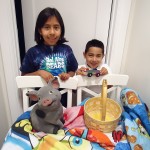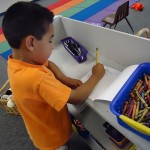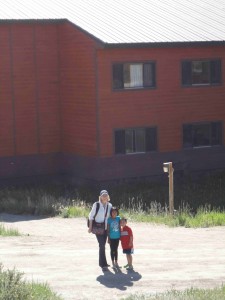Posts Tagged ‘Colorado Heritage Camps’
Latin American Heritage Camp
Monday, February 22nd, 2016Summer Vacation
Monday, June 20th, 2011No lunches to make, no bus to run for, no shoes to find, no totes to pack. The kids are sleeping late.
Yes, today is the first Monday of summer vacation.
Last night, Olivia and Mateo rode bikes and scooters until dark while Tim and I shot hoops–as in basketball. When’s the last time we did that?
This week, we head for Colorado and Heritage Camp, where Mamalita is the book club selection–available on Kindle and Nook for easy downloading–and then I go to the fabulous Prairie Lights Bookstore in Iowa City to read on Tuesday, June 28 at 7 p.m. My friend, Gretchen B. Wright, will meet me there–Gretchen and I met at a writing workshop at Lake Atitlan, Guatemala–as will other friends through adoption.
But first, a few photos. The playground at Mateo’s school, alive with students and teachers dancing to the Slumdog Millionaire anthem, Jai Ho. Olivia and Mateo presenting Tim with his Father’s Day gift, a miniature skateboard handmade by Mateo in a woodshop class, against a backdrop of their own design. And finally, Mateo drawing during his last day as a kindergartener.
Another year, gone.
Heritage Camp and Mamalita
Wednesday, March 16th, 2011I cannot believe that it’s almost time for Heritage Camp. Something else I cannot believe is that I have been blogging at this site for more than a year! Yes, friends, the first Mamalita post appeared in February 2010, nine months before my book was published, and soon after my publicist at Seal Press, Eve Zimmerman, said “You need to build your platform. Have you thought about starting a blog?” To which I answered, “Honestly, no. I haven’t.”
What I didn’t say, but I’m sure Eva understood, is that writing Mamalita had required my every molecule of writing energy and focus. Answering emails drained me enough, and thank goodness I hadn’t yet discovered Facebook. Could I add blogging to the mix? Add it to the mix I did, and found I really liked the practice. (My husband often calls me “the mad blogger.” ) My plan is to continue until I finalize my ideas for my next book and commit myself to a schedule for writing it. There are super-human people who can do both–focus on a manuscript and blog daily–but I don’t think I’m one of them.
Meanwhile, back to Heritage Camp. The great news is that for the fourth consecutive year, our family is attending Latin American Heritage Camp in Fraser, Colorado, and this year Mamalita: An Adoption Memoir is the book club selection. Yippee! If you’re going, please plan to join us on Friday night for a discussion. At some point during the weekend, I’ll also be leading an adult workshop on memoir-writing and the adoption experience. Stay tuned for details.
For those who are unfamiliar with Heritage Camp, I’m re-posting a section of my blog from last April so you can read all about it.
One of the very few places in the world where our family does not stand out as different is Colorado Heritage Camp. For the uninitiated, heritage camps are designed specifically for adoptive families of all kinds. The camp we attend is geared toward families with children from Latin America; camps are also designed for families with kids from Africa and the Caribbean, Cambodia, China, India and Nepal, the Philippines, Korea, Russia, and Vietnam.
Our family loves Heritage Camp. This will be the third year we attend. For a long weekend in June, we’ll stay in a YMCA lodge in the Rocky Mountains, along with other adoptive families from around the country. During the day, our kids will play games and do art projects that emphasize their Latin American culture. We adults will attend workshops and roundtables led by experts in adoption and child-rearing. Not all activities are scheduled: Families also find time to swim, hike, shop at the mercado, and practice their samba dancing at the Saturday night fiesta.
Every year, camp opens with an opening ceremony where the kids parade into the meeting hall carrying flags from the countries where they were born. As Olivia waited her turn the first year, she said to me with awe in her voice, ”Everyone here looks like us.” I was too choked up by the sight of our beautiful children carrying their flags to respond, but I squeezed my daughter’s hand to let her know I agreed. Olivia and Mateo hope to attend Heritage Camp every year until they turn 17. After that, their plan is to become counselors so they can be the “big kids” they now look up to.
Guatemala Part 7: Spanish School redux
Monday, February 28th, 2011Several people have asked if I recommend studying Spanish in Guatemala. Absolutely, yes. Language schools exist throughout the country, but we only have studied in Antigua. Last August, we spent a month in Guatemala and I posted a blog about our experience at one school, San Jose El Viejo. I’m reposting the blog here.
This summer at Latin American Heritage Camp, a panel of teen and adult adoptees dedicated a large percentage of their discussion to the importance of learning, speaking, and/or retaining the language of one’s birth country. The consensus was that language is critical if one wishes to interface with birth family, foster family, orphanage family, or, indeed, the culture at large, in a meaningful way. That’s true in my own life, as well: Speaking even elementary Spanish has allowed me to communicate with many more people in Guatemala than I would be able to otherwise.
Not that teaching a child a second language is easy. For my husband and me, it has been anything but that. Neither of us is fluent in Spanish, which is our biggest obstacle. And not only do we not employ a nanny who speaks Spanish, we rarely, if ever, hire a babysitter. Our local public school is not bilingual, and though we have a few Spanish-speaking friends, their children prefer to speak English while playing with our kids. This year, in third grade, Olivia will study Spanish. We’re lucky that it’s the second language taught in California schools. What about the kids adopted from Nepal or Russia or Ethiopia? How do they learn to communicate with others from their homeland?
The good news is that during this past trip to Guatemala, Olivia saw and understood the benefits of speaking Spanish. While listening to one conversation I carried on with someone, she said with admiration, “Mom, you speak a lot of Spanish!” Reader, believe me, I don’t. But you get the idea: In a real-life example, my daughter realized the efficacy of learning a second language. You can talk to people who don’t speak English!
Guatemala is renowned for its language schools. Here is link to a list of some of them. For the last weeks we were there, I managed to convince Olivia to attend morning classes while I posted my blog. She agreed that learning new vocabulary while drawing pictures and making figures with clay was a lot more fun than watching me wrestle with my USB flash drive at Conexion. The photo above is of her with her maestra.
For anyone who is considering Spanish school, I say “go.” Olivia attended San Jose El Viejo–because it was closest to our apartment and because the children of a woman I met through an adoption listserve were attending—and loved it. But I don’t think you can go wrong with any of them.
I’m not deluding myself into believing that Olivia speaks Spanish, or will retain any of the information that she learned. Now that she’s visited Guatemala, though, and attended school, she sees that speaking Spanish is an attainable goal, and one that multiplies her opportunities to communicate. That one outcome, to me, makes the entire trip worthwhile.
Cultural awareness and Guatemala news
Tuesday, January 11th, 2011As an adoptive parent to two children born in Guatemala, I’m often asked how I keep our children’s culture alive. After first repeating how important culture-keeping is for our family, I list some of what we do: Study Spanish, collect and study Guatemalan arts and crafts, follow Guatemalan politics and current events, listen to Latin music, eat Central American food, attend culture camp, visit Guatemala.
But is this enough? I often wonder what else I can do to keep my children’s birth culture alive.
That’s why I was very happy to find a related article by first-generation, Colombian-Argentine writer Jennifer Lubrani, a contributor to Travelojos, The Latin American Travel Blog. In the piece, “My New Year’s Resolution: Get Cultured,” Lubrani describes the five ways she vows to learn more about her culture this year.
Learn the language.
Dance.
Celebrate Hispanic Heritage Month.
Comida, por favor.
Read.
Reading Lubrani’s list made me feel better about our efforts. Except for studying Latin dance, we are doing everything she recommends. (2011 may be the year we finally sign up for salsa.) It was also nice for me to read that even for Lubrani, growing up in a Spanish-speaking home with two biological parents, culture-keeping remains a challenge. Another good point Lubrani makes is that each Latin culture is unique, different from every other. Guatemala is not Mexico, nor is it Costa Rica. Lubrani writes:
I’m a first-generation Colombiana/Argentina. My parents migrated to New York from South America many años ago. Growing up, I was fortunate enough to have parents who taught and encouraged my siblings and I to keep traditions and customs from their homelands.
As a result, I’m bilingual and I can speak to you as if I were a bonafide “Rola” from Bogota or transition into sprinkling lots of “che” into my conversations as if I were a native Porteña from Argentina.
I’ve also come to appreciate the many traditions that are shared between both countries such as a passion for fútbol or making sure family comes above all else. However, I’ve also learned cultural aspects that make these two countries seem worlds apart.
Peach
Friday, September 24th, 2010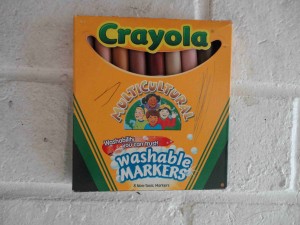 Last week, while drawing a picture of our family, Olivia held up the marker she was using to draw me and said, “Everyone at school calls this ‘skin color,’ but it isn’t. This color is ‘peach.’”
Last week, while drawing a picture of our family, Olivia held up the marker she was using to draw me and said, “Everyone at school calls this ‘skin color,’ but it isn’t. This color is ‘peach.’”
I’ve heard it said that children don’t notice skin color, but that has never been the experience in our family. In a very matter-of-fact way, Olivia began commenting on variations in skin color at about age three. Mateo, too. Maybe it’s because they’re such visual people and my husband and I look different from them; or maybe it’s because my husband is a dermatologist who studies, treats, and writes about the skin; or maybe it’s because our family looks different from most of the families around us. It could be due to any of those reasons, but here’s my theory: The reason my kids discuss skin color is because when the subject comes up, we don’t avoid it. For whatever reason, in our family, a conversation might sound like this:
Olivia: “Which girl are you talking about? Does she have peach skin?”
Mateo: “No, the other one. She’s brown like us.”
Or, Olivia: “Mom has peach skin with round spots.”
Me: “Those are freckles. ”
Mateo: “Olivia’s skin is tanner than mine. Dad’s skin has more yellow.”
My children often identify people by skin color, with no judgment attached. They report color the same as any detail: green eyes, long hair, good at bike riding, likes to hula-hoop. Olivia and Mateo know we’re all the same on the inside. That’s one fact that doesn’t vary, and the one that counts. (more…)
Heritage Camp
Saturday, June 26th, 2010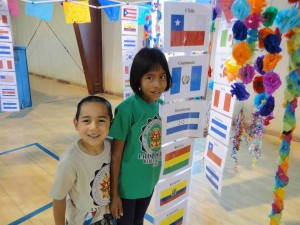 This is the third year I’ve been at the Opening Ceremony at Latin American Heritage Camp and I still cried. The children parade into the auditorium grouped according to their country of birth, carrying their country flag. The largest number of children were born in Guatemala—around 90—so they walked in first. Olivia and Mateo came in holding hands. Some other countries represented are Mexico, Belize, Honduras, El Salvador, Nicaragua, and Paraguay. Including presenters, about 450 people are attending.
This is the third year I’ve been at the Opening Ceremony at Latin American Heritage Camp and I still cried. The children parade into the auditorium grouped according to their country of birth, carrying their country flag. The largest number of children were born in Guatemala—around 90—so they walked in first. Olivia and Mateo came in holding hands. Some other countries represented are Mexico, Belize, Honduras, El Salvador, Nicaragua, and Paraguay. Including presenters, about 450 people are attending.
Being in a place where every family is a transracial adoptive family is extremely powerful. Olivia and Mateo feel this, too. Both of them are old enough to be aware that in their class at school, on sports teams, and in church, they are “the adopted brown kid with white parents.” At Heritage Camp, every child is adopted. I try to imagine a similar parallel in my life, and I can’t. Adoption is a defining experience like no other. Because I’m not adopted, I can never truly understand what that experience feels like. Being at Heritage Camp raises my awareness and sensitivity to how profound the experience is. (more…)



 ShareThis
ShareThis

